Xanthos Ancient City of Turkey – Great Lycian City
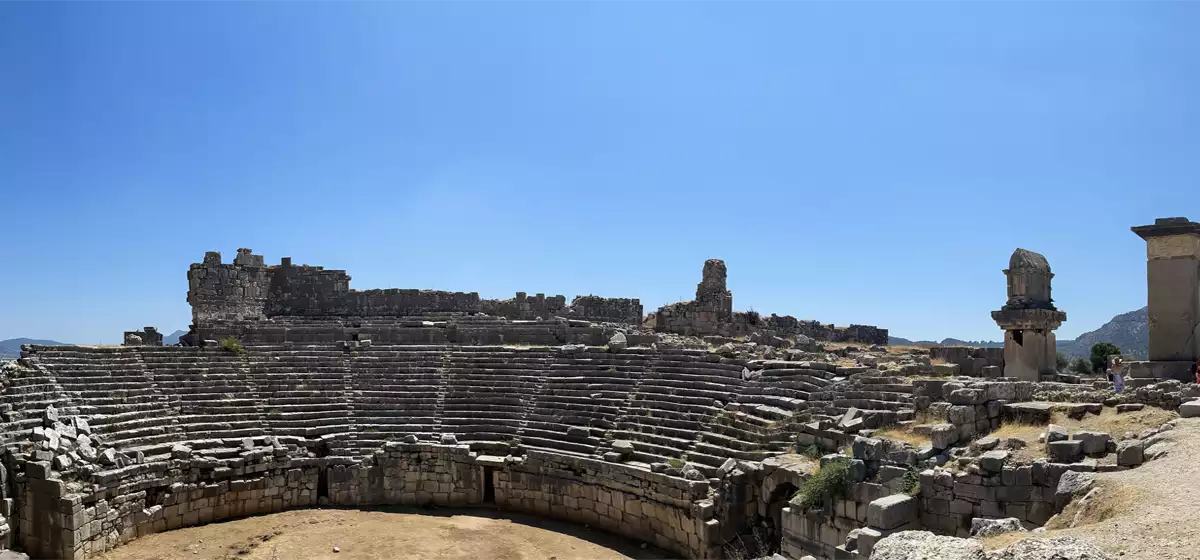
The Xanthos ancient city (also known as Ksantos) located in the town of Kınık on the Fethiye – Kaş road in Turkey is one of the six most important cities of the historical Lycian civilization.
The name of Xanthos, which is described as the administrative center of the Lycian League, is mentioned as ARNNA in the inscriptions written in the Lycian language.
The first settlement findings of the ancient city of Xanthos go back to 800 BC.
The Xanthos ancient city was founded on two dominant hills on the edge of the stream known as the Xanthos River (Eşen Stream), which passes through the Kınık Town of Turkey today. The first is the Lycian Acropolis, surrounded by ramparts built on steep cliffs by the Eşen Stream. The other is the Roman Acropolis, located further north.
The most important feature of the ancient city of Xanthos, which is on the UNESCO World Heritage list together with the Letoon ancient city, is the presence of mausoleums in the residential areas of the city. The Lycians built their tombs on the hills outside the city in other cities, but in the city of Xanthos, these tombs are intertwined with the city.
Since the Xanthos ancient city will be very busy during Turkey’s official or religious holidays, it is a good idea to check Turkey’s holidays before visiting the ancient cities.
You may also want to take a look at our Kas and Fethiye articles.
Don’t forget to see the ancient city of Patara and Patara beach, which are very close to the Xanthos ancient city!
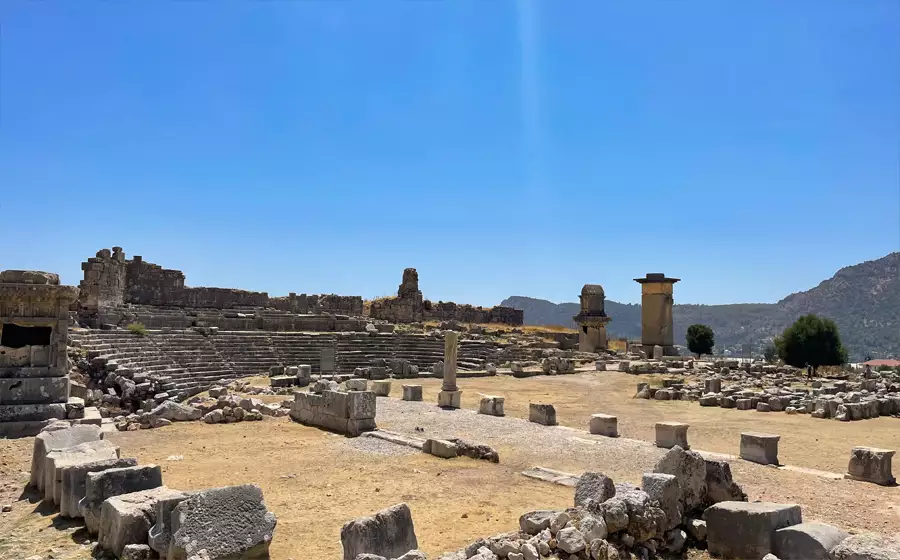
Table of Contents
- Xanthos Ancient City History
- Xanthos Ancient City Temples and Monuments
- Xanthos Ancient City entrance fees
- Xanthos Ancient City opening hours
- Xanthos Ancient City Tours
- How to get to the Xanthos ancient city?
- Frequently Asked Questions About Xanthos Ancient City
Xanthos Ancient City History
Together with the ancient city of Letoon, which is very close to the ancient city of Xanthos, it gained great importance in terms of religion for the Lycians. The Letoon sanctuary was established on the road from Xanthos to other Lycian cities, and the Lycians who made this journey were allowed to pass through the sanctuaries.
How old is Xanthos?
Located in Turkey, Xanthos became the religious capital of the Lycian League in 168 BC. In the excavations made in the ancient city, the oldest ancient BC in the city. It has been learned that it dates back to the 800s.
According to Homer, the Ionian poet who lived in Antiquity, the Xanthosians under the rule of Sarpedon, the son of Zeus and Laodamia, one of the main heroes of the Trojans, participated in the Trojan War.
According to historians, the city was destroyed many times due to wars or fire but was rebuilt again and again.
Xanthos City
The Xanthos ancient city was besieged by the Persian commander Harpagos in 545-546 BC. The people of Xanthos rebelled against the Persians but became helpless after a while. Xanthos warriors, after killing their women and children to avoid capture, burned the city and rendered it useless to the Persians.
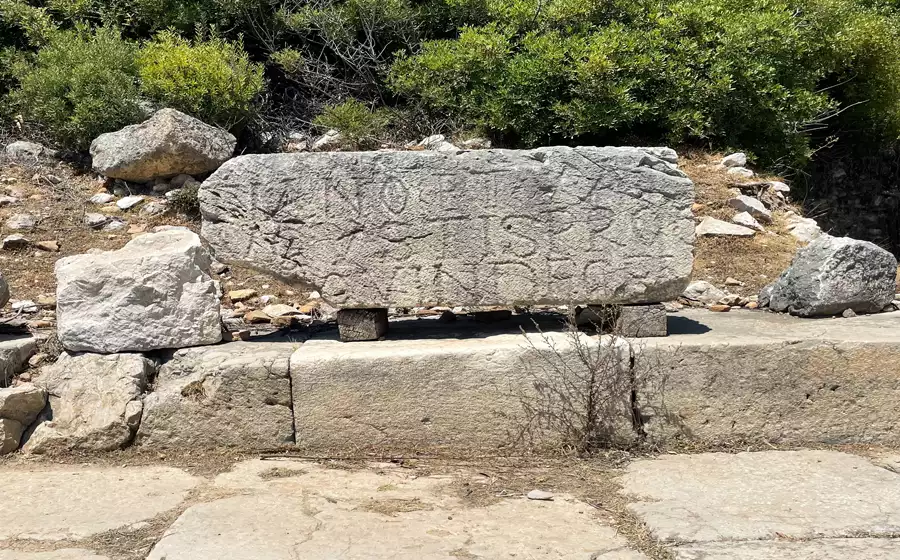
80 families who escaped from the city of Xanthos before the war returned to the ancient city of Xanthos and rebuild the city.
The city of Xanthos faced a great fire disaster between 475 – 450 BC and the city was devastated. The people of Xanthos rebuild the city after the fire.
The Athenian commander Melesandros wants to collect taxes from the Lycian cities. All Lycian cities unite and fight against Melesandros. Melesandros dies in the war in 429 BC and all ties between Lycia and Athens are severed.
Alexander the Great captured the city in 334 BC. After Alexander’s death, the city passed to Alexander’s commander, Ptolemy, but a short time later, King of Syria III. Antiochus dominates the city.
In 42 BC, the city of Xanthos was occupied by the Roman Brutus. According to the Greek historians Appianos and Plutarch, the event took place as follows.
“Brutus, with a cavalry attack, killed about 600 Lycian soldiers and advanced and captured many villages and defense points. But he released the captives in order to be nice to the Lycians. The Lycians, who were defeated, gathered in the city of Xanthos and Brutus besieged the city. While the Xanthosites tried to set the Roman siege towers on fire, some 2000 Roman soldiers managed to enter the city. Recognizing that they lost the war, the Xanthosians killed their families with their own hands before being captured. They set the whole city on fire. Seeing a woman jumping into the fire with her child in her arms, Brutus was very upset and told his soldiers that he would “reward those who save the Xanthosians,” but it was too late.”
The destroyed city was rebuilt by the emperor Mark Antony.
As a result of the earthquakes in the 2nd and 3rd centuries AD, like all the Lycian cities, Xanthos was severely damaged and could not be recovered. M.S. As a result of Arab raids in the 8th century, this region was completely abandoned. Later, the Turkish Kınık tribe settled here.
As you can see, Xanthos has been destroyed and rebuilt many times. On this subject, the following is written on an inscription found in the ancient city of Xanthos.
“We made our houses graves, we made our graves houses. Our houses were destroyed, and our graves were looted. We went to the top of the mountains, we went under the ground, we were under the water. They came and found us, they burned us down. They plundered us. We, for the sake of our mothers, our wives, and our dead, preferred mass deaths for the sake of our dignity and freedom. People of this land, we left a fire behind. The one that never goes out and never goes out.“
This inscription has been translated by AZRA ERHAT.
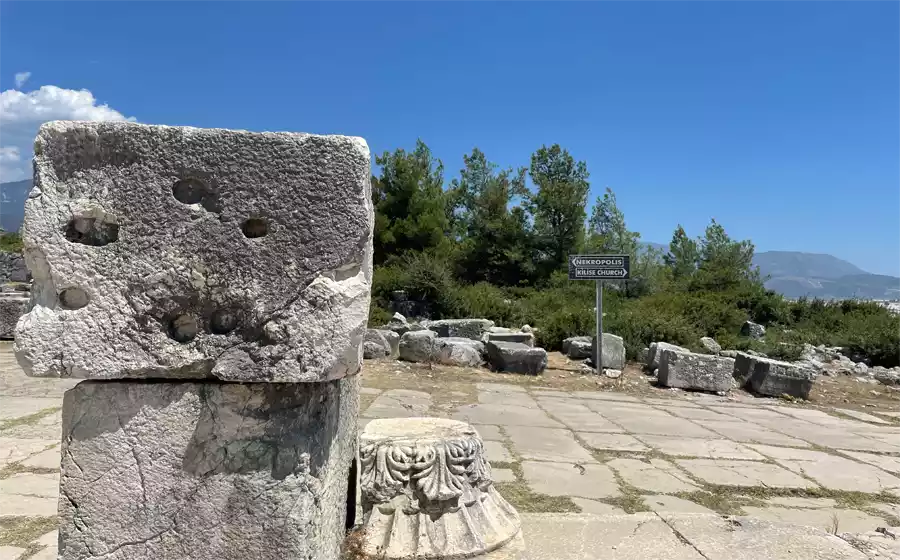
Xanthos Ancient City Temples and Monuments
Many buildings have been gained to the city, which has been occupied and rebuilt many times. Here are some structures you can visit in the Xanthos ancient city.
Harpy Tomb
The Harpy Monument, one of the most important symbols of the ancient city of Xanthos, is located right next to the Theatre. The Harpy monument, on a high rectangular monolithic pedestal, has his deceased family and “Harpy” reliefs, which are creatures with female bodies and bird wings, believed to carry the souls of the dead to the sky.
It is estimated that the Harpy Monument was built in the 5th century BC and the original reliefs are exhibited in the British Museum today.
Next to this mausoleum is another 4th-century Lycian sarcophagus with a pedestal.
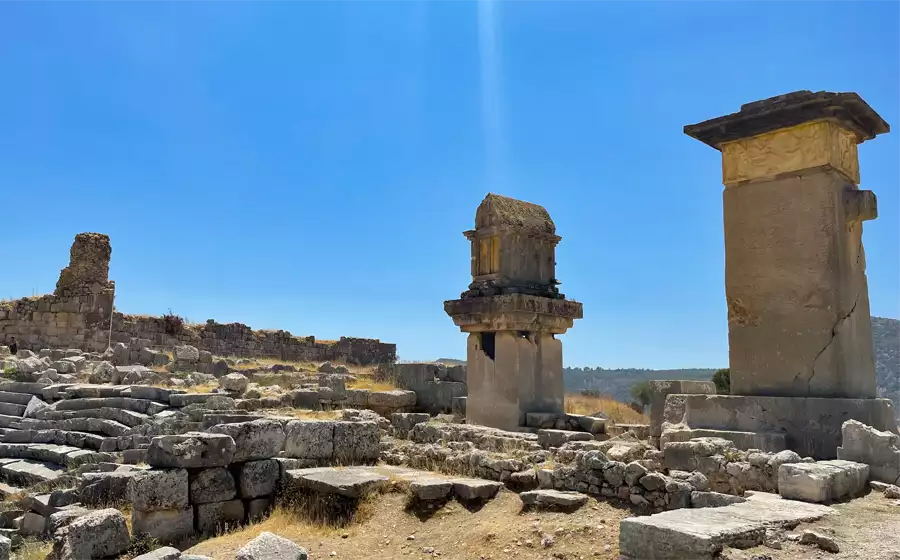
Roman Theater
The Theater, which is thought to have been built by the Romans in the 2nd century AD, is located next to the Harpy Monument and the Lycian Sarcophagus. It is opposite the Lycian acropolis.
Only the lower parts of the theater have survived to the present day. It is possible to see reliefs on the theater columns.
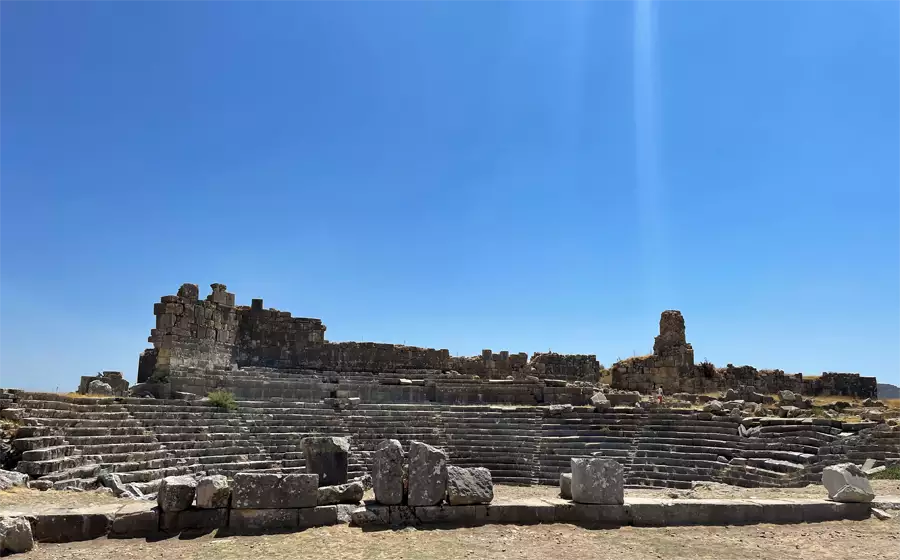
Inscribed Pillar of Xanthos
The monument built for the twelve Lycian gods is located right next to the agora. It has four faces engraved in Lycian, ancient Greek, and Milyan languages. This written monument is the largest written monument among the Lycian cities.
In the Written Xanthos column in the city of Xanthos, apart from the address to the gods, it also mentions the king Kheri, who won a victory over Athens. There are 12 lines of Greek inscription for King Kheri.
Agora
The agora in the ancient city of Xanthos is surrounded by colonnades consisting of rows of columns. There is also a three-room Byzantine basilica decorated with mosaic flooring. The basilica is thought to have been destroyed during Arab attacks in the 7th century.
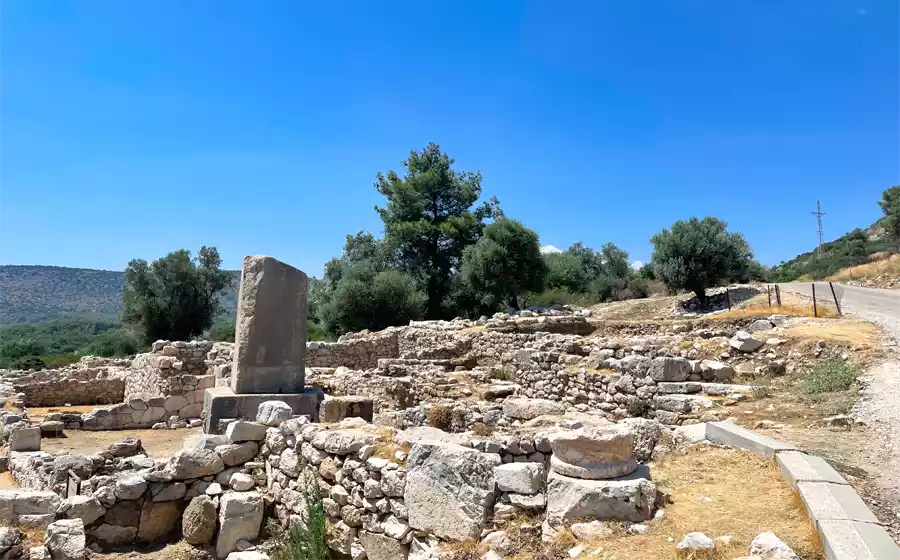
Nereids Monument
There are many rock tombs and pedestal tombs in the Roman acropolis. All sarcophagi are exhibited in the British Museum, except for the Lion Tomb, Payava, and Merehi sarcophagi on the south side of the acropolis. The Nereids monument with a temple plan belonging to the 4th century BC, on the right side of the ramp leading to today’s ruins, is one of the world-famous monuments of Xanthos, which is exhibited in the British Museum.
According to UNESCO, the mausoleum of Halicarnassus, one of the seven wonders of the ancient world, was built under the direct influence of the Nereids monument.
Xanthos Ancient City entrance fees
The entrance fee to the ancient city of Xanthos is 50 Turkish Liras per person. If you have a museum pass card, admission is free.
Xanthos Ancient City opening hours
The working hours of Xanthos Ancient City are between 08:00 – 20:00 between April 1 and October 1, and between 08:30 – 17:30 between October 2 and March 31.
If you go to the ancient city of Xanthos in the early hours, do not forget to visit the Letoon ancient city, which is very close to the sacred site of Lycia.
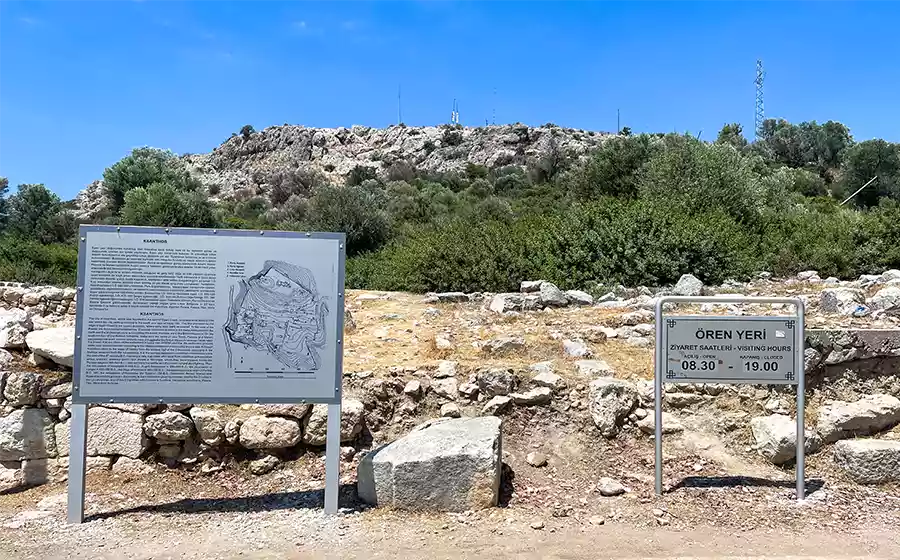
Xanthos Ancient City Tours
There is not only a tour of the city of Xanthos but there are many ancient and natural beauties around. Although it varies according to the tours, the route of the tours departing from Kaş or Kalkan, in general, is Xanthos Ancient City, Saklikent Gorge, and Patara Beach. Tours on this day start from $55.
SEE OFFER Saklikent Gorge Day Trip (includes Xanthos Turkey and famous Patara Beach)
If you are on holiday in Kas, Kalkan, or Fethiye, I strongly recommend you spare a day for these tours. Book now for the most affordable tour to the ancient city of Xanthos from Kas or Kalkan.
How to get to the Xanthos ancient city?
The Xanthos ancient city is in the town of Kınık in Antalya’s Kaş district. This area is on the Kas – Fethiye highway.
The ancient city of Xanthos is 49 km from Kas and takes about 45 minutes. It is 62 km from Fethiye and takes about 53 minutes.
You can check the Kas – Xanthos road map.
You can take a look at the Fethiye – Xanthos road map.
You can go to the ancient city of Xanthos from Kas or Kalkan by local minibusses. After getting on the Kaş – Kınık minibusses, you can go to the Turkey Xanthos ancient city.
From Fethiye, you can take the Kas buses and get off at the entrance of Kınık town. You have to walk about 1km or take the Kaş – Kınık minibusses on the road.
Our advice is to go to the ancient city of Xanthos on a tour or rent a car from Turkey and visit places such as Letoon Ancient City, Patara Ancient City, and Saklıkent Canyon.
In one day, you can visit the ancient city of Xanthos, the ancient city of Letoon, the ancient city of Patara, and you can swim on Patara beach.
If you are thinking of renting a car in Turkey, I recommend you to use international companies. Here you can take a look at the affordable car rentals.
If you are planning to go to the ancient city of Xanthos by plane, you can choose Dalaman Airport. The Xanthos ancient city is 105 km from Dalaman Airport and takes 1 hour and 30 minutes.
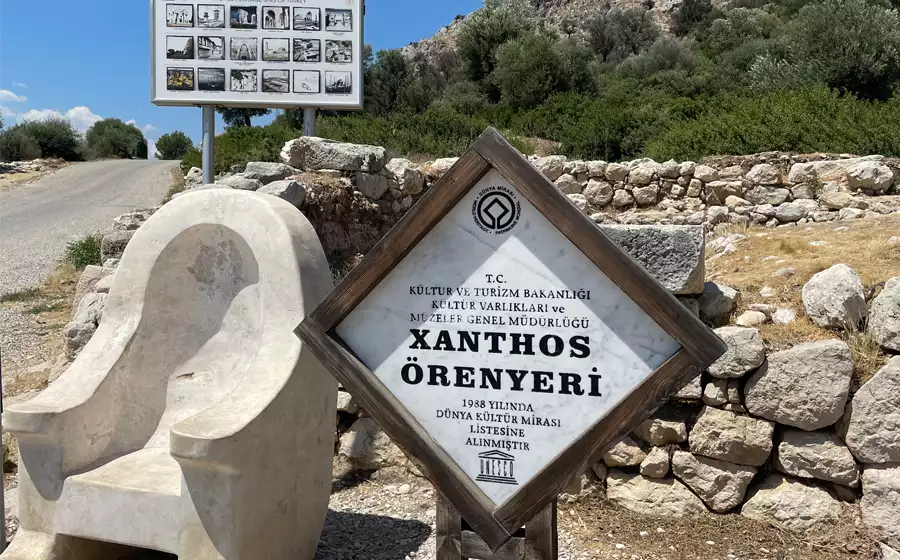
Bonus: Xanthos ancient city video;
Frequently Asked Questions About Xanthos Ancient City
Here I gathered up top asked questions about one of the most ancient cities in the Mediterranean! If you come to Turkey’s Mediterranean coast, don’t forget to stop by this archeological site.
What is a Xanthos?
Xanthos is an ancient city located in the west part of Antalya, Turkey. There is no ancient place named Xanthos Marmaris. So, where is Xanthos? Xanthos Antalya is located in the west part of Antalya province in Turkey.
Is it Xanthus or Xanthos?
It is Xanthos. The ancient city Xanthos is located in Antalya, Turkey. It is open everyday. Xanthos ancient city entrance fee is 50 TL but if you have a museum pass card, it will be free for once.
Look at!
Letoon Sanctuary Place: Letoon Ancient City
One of the best beaches: Kaputas Beach
Vacation in Fethiye – Things to do in Fethiye
Things to do in Kas
